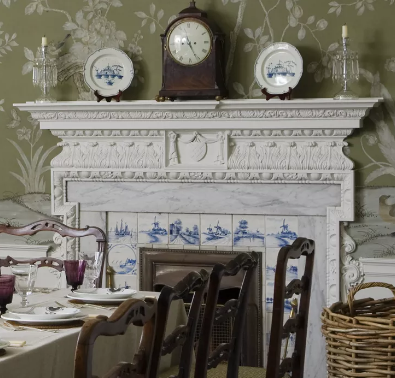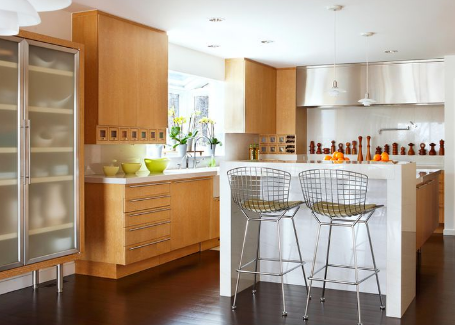
8 Ways to Create a Stress-Free Bedroom and Improve Your Sleep
November 28, 2024
What Is a Sofa Table? How to Create a Living Room Staple
December 4, 2024What Are Delft Tiles? Learn About Their History and a Guide on How to Use Them
Featuring blue and white depictions of mythical creatures and agricultural scenes, Delft tiles are an iconic product in the world of home design, and have recently made a comeback with fresh colors and imaginative portraits. With copycat cores and retro design styles becoming more popular, today’s designers and homeowners are looking to Delft tiles to incorporate historical elements into their homes.

What Are Delft Tiles?
Although inspired by Chinese blue and white porcelain, Delft pottery is actually pottery, a type of ceramics. It is covered with a tin glaze that makes the piece white, shiny, and opaque – an ideal backdrop for delicate blue patterns. While some tiles are heavily printed with patterns, Delft pottery is often hand-painted by artisans. Realistic Dutch scenes and absurd tales involving farms, flowers, sea boats, merfolk, David and Goliath can be found on these tiles. Despite the artisan design, these tiles are easy to clean, which is why they are often used in hard-working areas like kitchens and bathrooms.
Delft Tile History
Delft tiles have a rich history of more than 400 years and were first produced in the Dutch city of Delft in the early to mid-17th century. After the invention of Delft pottery, craftsmen used the same process as tin-glazed pottery to create tiles decorated with individual patterns, factory markings, and monograms.

The tiles were originally made to beautify dark and jet-black fireplaces. These tiles are heat-resistant and easy to clean, which, combined with beautiful colors and designs, make the basic fireplace the focal point. When Dutch homeowners saw the effect of tiles for fireplaces, they were soon used as a charming waterproofing material all over the house. This trend eventually spread to the UK, but it didn’t last long. The production of Delft pottery slowed to near extinction at the end of the 18th century. However, the use of ceramic tiles is back and more personal than ever, with hundreds of artisans making custom Delft tiles for homeowners around the world.
How to Use Delft Tiles?
Delft tiles are still stunning around the fireplace, in the kitchen backsplash, in the shower, and even covering the entire room. Or strategically place them to form a mural of any size and theme of your choice.

When deciding how to use Delft tiles in your own home, explore the portraits, corner decorations, and patterns you already have, or consider customizing them. Get inspiration from Delft tile designers’ websites, magazines, or social media, as there are countless ways to use and arrange them.
Once you have the tiles, arrange them on the floor or countertop in a variety of ways to see what they will look like once installed. Better yet, sketch out your vision before you buy. If desired, you can also use blank tiles to create space between designs. Stephen Orr, Editor-in-Chief of Better Homes & Gardens, recommends buying regular Delft tiles from the same company from which you buy the blue and white designs so that the thickness is consistent throughout the project.
When Orr renovated his home in Cape Cod, which was built around 1750 to 1780, he chose to use Delft tiles in the kitchen backsplash behind the stove and in the kitchen opposite the stovetop. “The kitchen has been destroyed and poorly refurbished many times. My husband and I wanted to find a way to reintegrate history into the house,” he said.

Orr’s purpose was to pay homage to the English settlers who used to call his house home. Before renovating, he studied examples of historical and modern British design, and noticed Delft tiles throughout.
“Our house was probably where the British lived in the 1750s and 1780s, who would have come here at a time when Delft tiles were popular in England,” he said. “Tiles have helped us add a touch of history to our modern kitchen.”
Orr chose Delft tiles from the marine collection of the British tile company Douglas Watson. The designs are far from serious, but illuminate the room and tie in the history of the imagination. “I also wanted them to be quirky and funny, so I had a lot of sea creatures and mermaids, Neptune characters, a kid holding a fish, a guy in a clam, and anything I could find – pictures of boats, pictures of islands with boats with funny little cabins on top. I was just trying to find 20 nautical-themed series.”

How to Install and Maintain Delft Tiles?
Once the layout is planned, it’s time to install the tiles. It is advisable to use lime-based mortar when installing Delft tiles, as it allows the tiles to stick firmly to the wall while also preventing damage to the tiles when removing them. Use a grout that is similar to the color of the tile or dark to create contrast. The width of the grout line should not exceed 1-2 mm.
Tiles can be cleaned with a damp cloth and a mild pH-neutral detergent, followed by a dry cloth to remove moisture. For dirt on the grout line, a toothbrush works well. To restore shine, wipe the tiles with a dry cotton cloth. Make sure to avoid too much moisture as it can cause salt crystals to grow, which can cause the glaze to separate from the tile.
A Modern Twist on a Classic
Today’s Delft tiles present a new interpretation of the original design. British designer and homeware brand Petra Palumbo uses a variety of colors in its handmade Delft tiles. The color palette includes blue, green, manganese, red, tan, and mustard, which will be available this fall. Many of their quirky designs include umbrellas, rubber ducks, and shaving brushes, while customization allows for the choice of any pattern or illustration. Mix and match colors and designs to create a truly one-of-a-kind home design.
“My tiles have a universal appeal because anyone can apply these designs to their lives. I’m sentimental, so I always try to capture and honor happy memories for my loved ones,” Palumbo said. “Tiles can elevate any space without making a huge difference. I sometimes use cement grouts in tone-on-tone or contrasting colors to make them pop and accentuate the characteristic irregular edges. ”




